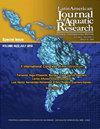Gross energy levels in practical diets for the Amazon river prawn postlarvae, Macrobrachium amazonicum
IF 0.8
4区 农林科学
Q3 FISHERIES
Latin American Journal of Aquatic Research
Pub Date : 2023-04-30
DOI:10.3856/vol51-issue2-fulltext-2965
引用次数: 0
Abstract
The present study evaluated the effect of different energy levels (15.07, 15.91, 17.17, 18.00, and 19.68 kJ g-1 of diet) on isoproteic practical diets for Macrobrachium amazonicum during the nursery phase on the zootechnical performance and proximate composition of the whole body. Postlarvae with a mean weight of 0.043 ± 0.01 g were stored in 25 experimental units, at 150 animals per m2, in a completely randomized design with five treatments and five replicates. The post-larvae were evaluated at the end of the experimental period according to the pre-established performance parameters. The analysis of variance for regression (α = 0.05) allowed us to estimate that the maximum final weight was observed in the treatment with 16.74 kJ g-1. In contrast, the lowest apparent feed conversion was observed at the 16.43 kJ g-1 level. The best values were found in 17.29 and 17.50 kJ g-1, respectively, for the energy and protein retention rates. As the best fit of the equation was presented for the energy retention ratio (R2 = 0.63), which approached the treatment of 17.17 kJ g-1, this energy level is recommended in postlarvae diets.亚马逊河对虾幼虾后期实际饲料中的总能量水平
本研究评价了育苗期不同能量水平(饲料15.07、15.91、17.17、18.00和19.68 kJ - g-1)的异蛋白实用饲料对亚马逊沼虾动物生产性能和全身近似组成的影响。试验采用完全随机设计,5个处理,5个重复,放置25个试验单元,平均体重为0.043±0.01 g,每m2 150只。试验结束后,根据预先设定的生产性能参数对幼虫进行评价。方差回归分析(α = 0.05)使我们估计在16.74 kJ -1的处理中观察到最大的最终重量。而表观饲料系数在16.43 kJ -1水平时最低。能量和蛋白质的最佳保留率分别为17.29和17.50 kJ -1。能量蓄积比与公式最拟合(R2 = 0.63),接近17.17 kJ -1处理,推荐在幼虫后日粮中使用该能量水平。
本文章由计算机程序翻译,如有差异,请以英文原文为准。
求助全文
约1分钟内获得全文
求助全文
来源期刊

Latin American Journal of Aquatic Research
FISHERIES-MARINE & FRESHWATER BIOLOGY
CiteScore
1.70
自引率
10.00%
发文量
44
审稿时长
4-8 weeks
期刊介绍:
Latin American Journal of Aquatic Research- LAJAR is the continuation of the journal Investigaciones Marinas (1970-2007) and is published since 2008 by the Escuela de Ciencias del Mar, Facultad de Ciencias del Mar y Geografía of the Pontificia Universidad Católica de Valparaíso. LAJAR is an “Open Access” journal that publishes in English language, original research articles, reviews and short communications on aquatic science, which contain the results of research conducted in aquaculture or in oceanic and coastal marine waters of Latin America.
The following topics are considered: Physical Oceanography, Chemical Oceanography, Marine Biogeochemistry, Marine Pollution and Toxicology, Marine Geology and Geophysics, Biological Oceanography, Fisheries and Aquaculture.
 求助内容:
求助内容: 应助结果提醒方式:
应助结果提醒方式:


